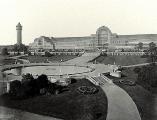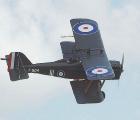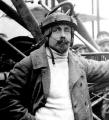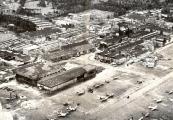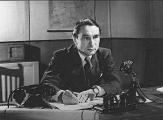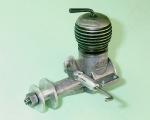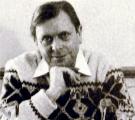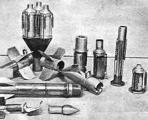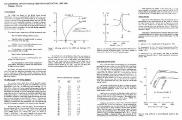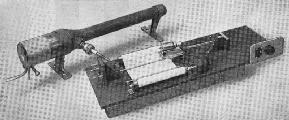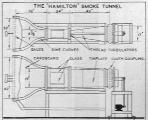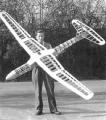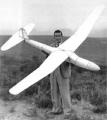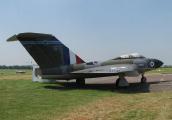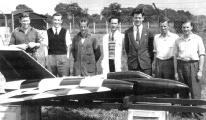The Low Speed Aerodynamics
Research Association (LSARA)
by Adrian Duncan
Click on images to view larger picture,
hover over the images for a description.
From time to time when researching articles on the history of British aeromodelling, I've run across references to an organization having the initials LSARA in connection with some aspect of the subject. After encountering these initials once more during the course of my study of the Allbon model engine range, I finally became sufficiently intrigued to do a little digging into the exact nature of the organization in question.
It turns out that the initials LSARA stand for an organization called the Low Speed Aerodynamics Research Association. This was an association of individuals having a shared interest in scientific research into the aerodynamic aspects of low-speed flight using model aircraft as the test subjects. By "low speed flight", the Association meant aircraft utilizing flying surfaces which operated at low Reynolds Numbers, a typical condition in model aircraft flight. A major goal of the Association was the encouragement of a free interchange of ideas and techniques between individuals involved in both full-scale and model aerodynamic investigations.
Rather to my surprise, information on this organization proved very difficult to locate—in itself an adequate justification for the compilation of this article. There are a few published details, but they're scattered all over, mostly being well buried in the pages of contemporary modelling and aeronautical magazines. However, by drawing on the full resources of the Internet, I've been able to put together a very broad outline of the history and activities of this group. I must emphasize that this account is necessarily incomplete and doubtless inaccurate in places. Any assistance in correcting any such inadequacies will as always be greatly appreciated and fully acknowledged.
As my research progressed, it became readily apparent that this was a model-oriented organization with a difference—it was very much focused on the scientific approach to the design and development of model aircraft and the transfer of the lessons learned to full-sized aerodynamic design. In a very real sense, it was Britain's (and perhaps the world's) first "Learned Society" relating to aeromodelling.
To understand how and why such an organization came into being, it's necessary to briefly review the organizational history of British aviation in general and aeromodelling in particular. I'll attempt to do this in the following section of this article. Bear with me ...it's all relevant!
Evolution
The LSARA was established in the immediate aftermath of WW2. At this time, aeronautics held a high place in the minds of many. After all, the RAF and the other Allied air forces had played a pivotal role in creating the conditions for an eventual Allied victory over the Axis powers. The tide of air-mindedness which occupied the minds of the British public as a result of this had a great deal to do with the burgeoning popularity of aeromodelling in post-war Britain.
However, the British public was not alone in taking a close interest in the field of aeronautics. Britannia supposedly ruled the waves, and many of those in official positions felt that there was no reason why she should not rule the skies as well! As a result, there was a good deal of official enthusiasm for ongoing aeronautical research, both within government and among the scientific community.
It's important to understand at this juncture that air-mindedness was by no means a new phenomenon in Britain. The first British organization devoted to aeronautics was the Aeronautical Society of Great Britain, which was rather surprisingly formed as long ago as January 1866, some 37 years prior to the world's first successful powered heavier-than-air flight. The new Society was active in promoting aeronautical research and development from the start, holding its first public exhibition in 1868 at the Crystal Palace in London. This event attracted no fewer than 78 distinct entries, including a small steam aero engine constructed by John Stringfellow, who had achieved Britain's first powered flight in 1848 using this engine in a 10-foot span model. Indeed, experiments with models played a significant role in the Society's activities.
The Society went on to sponsor Britain's first wind tunnel which was constructed in 1870-71. However, the focus of the organization was global rather than being confined to British aeronautical activity—indeed, notable winners of the Society's prestigious Gold Medal included the American pioneers Wilbur and Orville Wright, who received the accolade in 1909 during a visit to England in that year.
A companion organization relating to aeronautics was founded in 1901 as the Aero Club of Great Britain. This body was principally concerned with facilitating the sport of aviation as opposed to the furthering of aeronautical research. It was initially formed as a kind of "gentleman's club" for men of means having an interest in flying (principally ballooning in the initial stages), with a fashionably-located City clubhouse at 119 Piccadilly which it retained until 1961. Its stated goal at the outset was "the encouragement of aero auto-mobilism and ballooning as a sport."
Prior to 1908, the Club was principally concerned with ballooning, but the heavier-than-air flight demonstrations staged by the Wright brothers in France during that year convinced it to switch its focus to aircraft. In 1909 the Club established its first flying ground at Shellbeach near Leysdown-on-Sea on the Isle of Sheppey in Kent, with a flying ground clubhouse being created at nearby Mussell Manor (later known as Muswell Manor). On May 1st, 1909, John Moore-Brabazon (later Lord Brabazon of Tara) became the first British pilot to make a heavier-than-air flight in Britain when he achieved a flight of 500 yards in his Voisin biplane at this flying ground. During the same week the famous Wright brothers Orville and Wilbur were the guests of the Club at the field. A historic location indeed—in many ways, the birthplace of British aviation.
In 1910 the Club received Royal sanction to change its name to the Royal Aero Club, by which name it remains in operation today (2013). As time went on it became increasingly involved with the organization and regulation of non-military flying activities in Britain. It continues to fulfill this role today, acting as the national coordinating and licensing body for air sport and recreational flying in the United Kingdom in addition to serving as the British representative organization of the F.A.I..
It should be apparent that the activities of the Royal Aero Club were quite distinct from those of the previously-mentioned Aeronautical Society of Great Britain, which remained focused upon research and development relating to aeronautical design. However, the advantages of Royal patronage in terms of prestige were by no means lost upon the Directors of the latter body. In 1918 the Aeronautical Society of Great Britain received Royal assent to change its name to the Royal Aeronautical Society, thus following the path taken earlier by its colleagues of the Royal Aero Club.
The aeronautical element in the title of the Royal Aeronautical Society reflected its primary concern with the encouragement of the science of aeronautics as opposed to the activity of flying. In effect, it was a professional aeronautical institution rather than an aviation society per se. Through its various publications, it disseminated important information on aeronautical developments worldwide. It remained very active throughout the 1920's and 1930's, going on to play a key role in WW2 through the 1940 establishment of a Technical Department to advise the British aviation industry. These activities continued long after WW2, carrying over into the aerospace era. The Society remains a respected professional multi-disciplinary research institution to the present day, still serving the global aerospace community.
Another major force in British aeronautical development which turns out to be highly relevant to our story was the Royal Aircraft Establishment (RAE). This had been founded in 1918 as a replacement for the Royal Aircraft Factory which had been established in 1912 and had remained active throughout WW1, being involved in the design and manufacture of a number of British warplanes of that era, including the famous SE5a fighter.
The RAE was primarily concerned with practical aeronautical research rather than manufacture. It took over a site at Farnborough in Hampshire which had first been occupied in 1905 by the Royal Balloon Factory and from 1912 onwards by the successor Royal Aircraft Factory. In addition to inheriting all of the office space, hangar space and aircraft development, manufacturing and maintenance facilities of the Royal Aircraft Factory, the RAE also acquired the use of the neighboring airfield which was eventually developed to incorporate a 2200 meter long runway. This field was historically significant, having been the site of the first heavier-than-air flight in Britain by the American aviator Samuel Cody (no relation to Buffalo Bill!). This event took place in 1908, a year before John Moore-Brabazon made the first such flight by a British aviator and also a year prior to Louis Bleriot's historic cross-channel venture when he landed in England.
The RAE was to remain active through WW2 and for a long period thereafter, carrying on in fact right up to 1988, when it was re-named the Royal Aerospace Establishment in keeping with the changing focus of the times. In 1991 it was absorbed into the newly-established Defence Research Agency. Thus ended 73 years of service to the British aviation industry. The historic site at Farnborough is today occupied in part by the Farnborough Air Sciences Trust Museum. Well worth a visit.
The organization of research and development relating to model aircraft in Britain generally followed a parallel course, although it got off to a far later start. A very useful summary of the highlights appeared in the July 4th, 1946 issue of Flight magazine. The first step towards the organization of aeromodelling activities in Britain came in the early years of the 20th Century with the foundation of the Kite and Model Aeroplane Association (K&MAA). The onset of WW1 in 1914 brought about the premature cessation of this group's activities, but its place was taken immediately after the conclusion of hostilities in 1918 by a new organization named the London Aeromodellers Association. This body was founded by a group of pre-war London-area members of the K&MAA. These individuals approached their self-appointed task with such energy that the new Association quickly took over all of the functions formerly exercised by the K&MAA, to the extent that it became in effect the K&MAA's legal successor.
Not surprisingly, the London Aeromodellers Association quickly came to recognize that its activities extended far beyond the interests of modellers living in London and that a name change was therefore appropriate. This step was duly taken in 1922, with the London Aeromodellers Association becoming the Society of Model Aeronautical Engineers (SMAE). This organization still exists today (2013) as a Limited Company, although in 1987 it adopted the working title of the British Model Flying Association (BMFA) for operational purposes. In effect, the BMFA is the day-to-day working title of the parent SMAE, whose name remains in the background but is still used on all legal documents relating to the organization.
Returning to 1922, the new organization did not forget its roots as represented by the former K&MAA. For many years both before and after WW2 one of the SMAE's most prestigious annual competitions was for the K&MAA Cup, a contest which was specifically intended to encourage the further development of biplane models.
The SMAE gained in stature as time went by, to the extent that it became affiliated with the Royal Aero Club (not to be confused with the Royal Aeronautical Society, remember), which delegated a number of key tasks to the SMAE In addition to being made responsible for the control of National contests for model aircraft, the SMAE was also charged with the management of British participation in International model aircraft contests such as the Wakefield Trophy. The SMAE was also responsible for the ratification of all British record claims relating to model aircraft as well as the issuance to British competitors of the FAI Model Aircraft Competitor's Licenses which were a requirement for the ratification of World Record claims. The SMAE thus fulfilled the same organizational role in connection with model aircraft that the Royal Aero Club did for full-sized non-military aviation, hence the partnership.
The SMAE membership structure was very much oriented towards model clubs rather than individuals. In effect, it was a confederation of affiliated model aircraft clubs located throughout the United Kingdom, although a Country Membership category was created to accommodate individuals for whom club membership was not an option. The affiliated clubs were sub-divided into Areas with their own administrative Councils and officers who took on the responsibility for organizing flying meetings and competitions within their respective Areas.
Both before and during WW2, differences of opinion had arisen in connection with the philosophy and goals of the SMAE as well as its approach to the discharge of its assigned responsibilities. These differences came to a head in 1944 with the breakaway establishment of what was in effect a competing body having a broadly similar purpose. This was the Association of British Aeromodellers (ABA). The ABA had a greater focus on the provision of advice and assistance to individual aeromodellers, although it did organize flying events as well. It served as a forum for the provision of modelling advice, assembling a comprehensive reference library relating to all aspects of aeromodelling. It also maintained a watching brief on developing legislation as it might affect the activities of its members.
The three years or so following the creation of the ABA in effect constituted a "cooling-off" period during which it became increasingly apparent that time and distance were doing much to heal the divisions that had led to the creation of the ABA in the first place. Moreover, the organizational fragmentation of British aeromodelling was increasingly and quite reasonably seen as an impediment to the growth of the movement. Eventually cooler heads prevailed, the result being that the ABA merged back into the SMAE in the late 1940's. It thus had a very brief independent presence on the British modelling scene.
The LSARA Is Born
Prior to WW2, the activities summarized above relating to full-sized and model aircraft had been kept largely separate. The affiliation of the SMAE with the Royal Aero Club represented the first step in the establishment of closer links between the two categories, but this connection was confined to the organizational sphere. There was still no bridge between the research and development activities relating to the two fields. It was in large part to fill this gap that the Low Speed Aerodynamics Research Association (LSARA) came into existence immediately following the conclusion of WW2.
The LSARA was established as a technically-oriented association of individuals having an interest in some aspect of scientific research relating to model aircraft. Its membership was by no means geographically confined to Great Britain—it included Sections in a number of British Commonwealth countries, including Canada.
The goals of the new organization may be summarized as follows:
- To undertake aerodynamic research work using model aircraft operating at low Reynolds numbers, including work on suitable model power plants, and to publish the results;
- To develop an educational programme through which full-scale aircraft design features and techniques could be disseminated for application to models;
- To facilitate the application to full-scale aircraft design of lessons learned from model research.
It will be apparent from the above summary that the overriding goal of the Association may best be characterized as the encouragement of the interchange of aerodynamic knowledge derived from both full-sized and model investigations. In a very real sense, this made the LSARA Britain's first "Learned Society" devoted to model aircraft research.
A number of the individuals associated with the establishment of the LSARA were closely involved with the work of the Royal Aircraft Establishment (RAE) to which reference was made earlier. This of course greatly facilitated the achievement of the second and third goals set out above. The academic credentials of the newly-formed Association were significantly enhanced by the involvement of such luminaries as Dr. (later Sir) Harold Roxbee Cox (1902—1997), one of Britain's most respected aerodynamicists of the day. Dr. Cox was to go on to be elected President of the Royal Aeronautical Society for 1947-18, talking office on October 1st, 1947.
Other academically-qualified participants in the work of the LSARA included Mr HB Irving, BSc, FRAeS (Fellow of the Royal Aeronautical Society), who was a previous Assistant Director of Scientific Research (Air) at the Ministry of Supply and later served a term as President of the LSARA An early Vice-President of the LSARA was Professor AA Hall, MA, FRAeS. Clearly the Association did not lack for academic credentials!
The close association of the LSARA with the RAE had one very practical result—it allowed the new Association to secure facilities which were co-located with those of the RAE at Farnborough in Hampshire. The actual address of the LSARA Research Director at this stage was 23 West Road, Hawsley Lane Estate, Farnborough, Hampshire. The founding Research Director of the Association was Mr NK Walker, BSc, who was also a staff member of the RAE His deputy was the well-known model experimenter RHW "Bob" Annenberg of "Scalded Cat" fame. Ray Sharpe was another associate who contributed much to the work of the LSARA
Another member of the Association was the well-known aeromodeller and theorist John Halifax, who wrote extensively in the modelling press under the pseudonym "PR Payne". Using the latter pseudonym, Halifax contributed a piece to the January 1950 issue of Aeromodeller in which he characterized the LSARA as having "the finest equipment in the world for model research", including several wind tunnels suitable for the evaluation of model aerofoils. Again using his "PR Payne" identity, Halifax also collaborated with Lawrence H Sparey in the design of a series of custom airscrews for optimal performance with the various model engines tested by Sparey for Aeromodeller magazine beginning in May 1948.
Despite its lofty aims and the academic and technical credibility of its members, the LSARA was established on a very informal basis. Moreover, despite the fact that it received a small grant from the British Aeronautical Research Council, it was chronically strapped for cash with which to carry out its research aims. Consequently, the scope of work was dictated to a significant extent by the availability of outside funding. During its early years, the work of the Association was largely performed independently by its individual members at their own expense and on their own time, the role of the Association being to consolidate, edit and disseminate the results of these efforts.
The Association pursued the first of its three goals stated earlier by undertaking aeronautical research relating to models and distributing the resulting reports to its members. Individual members also published details of their findings in the aeromodelling periodicals of the day, notably Aeromodeller and Model Aircraft. In addition, the editor of the full-size aviation magazine "Flight" took an interest in the work of the LSARA, periodically including reports on its activities.
By September 1946 the LSARA had used two wind tunnels which they had constructed to develop a number of new aerofoil sections which were well suited to the laminar flow conditions encountered during model flight. These were duly published in Aeromodeller magazine, which then went on to present a technical series on the aerodynamic design of model aircraft, including the airscrews which drove them. The author of this series was the aforementioned John Halifax, this time using his own name! Technical articles of this nature by LSARA members continued to appear through the balance of the 1940's and well into the 1950's.
In keeping with the first of its goals set out above, the LSARA also took an interest in the ongoing development of model powerplants, periodically publishing the results of its own independent testing of newly-introduced commercial designs. A notable example of this was its test of the 0.55 cc Allbon Dart which was introduced in October 1950. In his later advertising for this engine, Alan Allbon quoted a statement from the LSARA to the effect that they had delayed publishing their test results for the Dart pending a series of re-checks since they found the established figure of 0.053 BHP @ 14,500 rpm difficult to believe for such a small engine! However, their later re-testing apparently confirmed this figure.
It's interesting to note that Peter Chinn was also a member of the LSARA, contributing a paper to the Association's first annual Conference in 1954 (see below). We have no information on Chinn's involvement with the Association's engine testing activities, but there's little doubt that he must have placed his extensive experience at their disposal. Another notable LSARA member who contributed a paper to that same Conference was 1936 Wakefield Trophy winner AA "Bert" Judge, who was the designer of the early FROG engines for International Model Aircraft and later became a key figure in the ongoing development of the Jetex range after joining Wilmot, Mansour & Co in 1952.
Speaking of Jetex, the LSARA did not confine its interest in model power units to reciprocating internal combustion engines. It also conducted a series of experiments relating to the development of small solid fuel jet and rocket engines for models. Ray Sharpe was the primary participant in this research, producing a series of miniature rocket motors which were charged with cordite. It was this activity which led to the subsequent involvement of the LSARA in the development of the Jetex Jetmaster solid fuel jet engine, an effort which was sponsored by Jetex manufacturers Wilmot, Mansour & Co. This addition to the Jetex range appeared in 1952. During the same period, the LSARA assisted Wilmot, Mansour & Co with the development of augmenter tubes for the Jetmaster and other Jetex models.
The achievement of the organization's second and third goals was naturally facilitated by the fact that a number of key members of the LSARA were on the staff of the RAE, which was of course devoted to aeronautical research relating to full-scale aircraft. The RAE was thus made immediately aware of any model-related research which appeared to have applicability to full-scale aeronautical development, and vice versa. As time went by, the Association became increasingly involved in a number of model testing programs relating to full-scale aircraft.
LSARA Comes of Age
The original rather loose-knit organizational structure of the LSARA was soon found wanting. For one thing, the location of the Association's research facilities at Farnborough placed them at an inconvenient distance from the major population centres within which most aeromodellers lived. Accordingly, a re-structuring of the organization took place in 1949, with the regular meetings of the LSARA Research Council now taking place in London at such exotic locations as the Athenaeum Club. In addition, some of the Association's research facilities were relocated to the London area. Despite these changes, the head office of the LSARA continued to be co-located with the research facilities of the REA at Farnborough.
One outcome of this reorganization was that Aeromodeller magazine began to include a monthly summary of the major accomplishments of the LSARA. This took the form of a short article which appeared under the heading "LSARA News" immediately following the regular "Club News" feature. As an example, the article for June 1949 noted the successful completion of LSARA Wind Tunnel number 3, which was constructed at Battersea in London and was to be operated by a London-based team led by Association member MM Gates. This tunnel had a 27:1 contraction ratio to minimize turbulence. The work of Gates and his colleagues was referred to as the Model Aerodynamics Research Project.
The LSARA's work on aerofoil sections was the subject of a retrospective paper presented by Thomas J. Patrick at the 1971 Symposium of the National Free Flight Society (NFFS). Sincere thanks are due to Alan Petersen of the NFFS for his kindness in making a copy of this paper available to us. Anyone having an interest in free flight will really enjoy a visit to the website of the NFFS.
We noted earlier that one of the major challenges facing the Association was a chronic shortage of funds with which to finance its ongoing efforts. It was at about this time that the Directors recognized the need to seek funding from outside sources, specifically by undertaking research projects which supported the objectives of commercial interests or Government agencies and for which they would therefore pay. In this context, the previously-mentioned June 1949 article noted the commencement of the LSARA's "Commercial Test" scheme whereby the ever-improving capabilities of the Association's research teams would be made available to the model aircraft trade, presumably at a price. Facilities were reportedly available for such activities as I/C engine testing, jet and rocket thrust testing, airscrew testing and flight testing and scientific analysis of new model aircraft designs.
As a result of such initiatives, by the end of 1949 the testing of commercial products relating to aeromodelling and the submission to the manufacturers of advice on potential improvements had become an important facet of the Association's work. Indeed, the credibility and capacity of the LSARA soon increased to the point that it began to undertake work not only for private commercial interests but also for Government agencies such as the Ministry of Supply and Ministry of Defence. Reportedly the advice of the LSARA was also sought by officials of at least one overseas government. In addition, the Association continued to facilitate ongoing research by its own members to the extent possible.
The situation of the LSARA at the end of 1949 was summarized in some detail in the previously-mentioned article by John Halifax, aka, PR Payne, which appeared in the January 1950 issue of Aeromodeller. Payne noted that the work of the Association had up to that time been almost entirely voluntary and unpaid, with members contributing as much of their own time and effort as they felt able. As always happens with volunteer organizations of this kind, the willing horses were rewarded with the lion's share of the work. This factor had resulted in much of the workload falling on the shoulders of Research Director NK Walker, in addition to his professional duties as a staff member of the RAE The inevitable consequence of the resulting overload was that Walker reportedly suffered a nervous breakdown during 1949. During his absence, Payne's wife had apparently taken over the tasks of office work and report distribution for the Association. The LSARA's Annual General Meeting for 1949 was cancelled as a result of these circumstances, while the annual meeting of its Research Committee was greatly delayed.
Despite these setbacks, the work of the LSARA was continuing. Activities which were proceeding at this time included testing of the relative efficiency of various commercial airscrews as well as related theoretical investigations. This work was evidently financed in part by the Model Aeronautical Press, publishers of Aeromodeller magazine. Research was also continuing on the development of jet propulsion for models. Following his previously-mentioned experiments with cordite-charged rocket motors, Ray Sharpe had moved on to pulse jets and had produced what was said to be the best unit of this type yet to originate in Britain.
Aerodynamic research was also continuing, with LSARA wind tunnel number 2 having been put back into service at Farnborough while tunnel number 3 continued in operation at Battersea. A further addition to the array of aerodynamic testing equipment available to the Association was a fourth wind tunnel constructed by D Henshaw and E Willing of the LSARA's Canadian Section in Hamilton, Ontario. This underscores the fact that the LSARA was indeed an International body having active membership in several British Commonwealth countries.
By 1950 the stature of the LSARA had grown to the point where it was able to occupy a stand at the prestigious Model Engineer Exhibition held that year at London's Horticultural Hall between the 9th and 19th of August. Items displayed at this exhibition included several diesel-powered vertical-climbing models reportedly capable of achieving a climb rate of 5,000 ft/min. The Association's major exhibit was a multi-channel radio control system which had been developed for the use of the British aviation sector in connection with meteorological research, anti-aircraft training exercises and scale model free flight dynamic research. Work on this project had begun in 1947, with flight testing scheduled to begin in 1951. The stand also featured a low-turbulence wind tunnel in which the efficiency of the LSARA's aerofoil sections could be demonstrated.
As a consequence of all these advances, the scale of research progressively increased. Government-sponsored projects of great relevance to modellers included a contract to further develop and test multi-channel proportional radio control systems in association with Murphy Radio. One of the models constructed during the course of this ongoing work formed part of the static display at the Royal Aeronautical Society's 1953 Garden Party at Hatfield Aerodrome commemorating fifty years of aviation history. This was a large 8-foot span radio-controlled glider which was powered by a slow-burning solid-fuel rocket motor giving 4 lb thrust for 90 seconds. The motor (which was definitely not a standard Jetex unit!) reportedly used no fewer than 63 Jetex slow-burning fuel pellets—a somewhat expensive though doubtless convenient method of obtaining altitude without a towline. Reportedly the model was later fitted with a 1-1/4 horsepower petrol engine.
The construction of the original 8-foot span model evidently came about primarily through what seems to have been a close tie-in between the LSARA and Wilmot, Mansour & Co, manufacturers of the Jetex range of solid fuel model jet engines and associated models. No doubt the fact that LSARA member Bert Judge had left International Model Aircraft in 1952 to joint Wilmot, Mansour & Co had much to do with this. We already referred to the involvement of the Association in the development of the 1952 Jetmaster motor along with the augmenter tubes which complemented the Jetex units. As part payment for these services, Bert Judge and Mike Ingram of Wilmot, Mansour built the aforementioned glider for use in the LSARA's Government-sponsored experiments with proportional radio control. This model was apparently based upon a rough design supplied to Wilmot, Mansour by LSARA Director NK Walker. Reportedly, a significantly larger model was later constructed which was powered by a 6 horsepower petrol engine. However, Wilmot, Mansour do not appear to have had a hand in the creation of this far larger model.
The LSARA's activities in connection with radio control development were of sufficiently high profile that they came to the attention of the British Aeronautical Research Council. The Council's 1955 published review of aeronautical research activities through the years 1949-1954 mentioned this project, noting that its success up to that point had paved the way towards practical free-flight testing of large models to supplement the results of wind tunnel research. This was seen by the Council as the ideal approach to bridging the gap between wind-tunnel analysis and full-sized prototype testing. The report noted the recommendation of the Council's Aerodynamics Committee that official support for this project be continued.
Although the LSARA appears to enjoyed a high level of success in connection with the radio control project, some Government work which was offered proved to be beyond their still-meager resources, leading them to outsource certain aspects of the research to others. A notable example of this arose in connection with stability problems encountered during the development of the Gloster Javelin jet fighter. Following a series of accidents, several of them fatal, the LSARA was asked to assist in the analysis of these problems. To this end, the Ministry of Defence contracted with the LSARA for the design and production of several dynamically-correct 10-foot span models that could be dropped from a dirigible and put through a pre-programmed series of maneuvers to test spin recovery. This complex project proved to be beyond the unaided resources of the LSARA, so they turned once again to their former clients Wilmot, Mansour & Co for help in the construction of the required models.
The project also stretched the facilities at Wilmot, Mansour, causing employees Bert Judge and Mike Ingram to undertake a good deal of the construction work on their own time after hours. It's actually possible that Joe Mansour (or the LSARA) may have subcontracted the tailplane construction to Adamcraft, a firm which had previously worked with Wilmot, Mansour on the design of their Jetex-powered hydroplane. However it was accomplished, two models were successfully completed and put to use. It's nice to be able to report that the project was successful, to the point that the Javelin ended up serving the RAF well as an all-weather interceptor aircraft throughout the balance of the 1950's and most of the 1960's.
Despite challenges such as these, the research budget of the LSARA progressively increased over time, from a mere �10 in 1947 to �600 in 1953-54. By 1954 the Association felt itself to be sufficiently well-established that it was able to host its first formal Conference, which it did on September 25th, 1954. The event took place at the offices of the Royal Aeronautical Society at 4 Hamilton Place in London. Its proceedings were reported in some detail by Flight magazine, giving us an invaluable snapshot of the organization as it existed as of this date.
At the time of this first Conference, the President of the Association was HB Irving, BSc, FRAeS. The membership of the LSARA at the time was stated to be approximately 100 individuals. The majority of these were reported to be around University age, a period in which their earlier enthusiasm for modelling was in the process of being transferred to an interest in full-sized aircraft. Presumably the Association was seen by these individuals as bridging the research gap between the two, just as it was intended to be. The Association was said to have accumulated a portfolio of over 50 published reports and papers by this date, with more on the way. Those wishing further information on the Association's activities were invited to contact the Secretary at 273 Farnborough Road, Farnborough, Hampshire.
The technical program included presentations on the history of the LSARA as well as the radio control development project mentioned earlier, the use of dynamically-correct free-flight scale models in testing full-sized design theories, scale effects in low-speed aerodynamics, the development of vertical-climb models (doubtless harking back to the 1950 Model Engineer Exhibition display), aerofoil characteristics at low Reynolds numbers and other papers of a highly technical nature. An interesting inclusion in the program was the reading by NK Walker of a paper by none other than Peter Chinn on the subject of model engine testing. In addition, PR Payne (aka John Halifax) read a paper by Bert Judge on the development of ducted rocket power units for models. This of course referred to the Jetmaster and augmenter tube projects previously carried out by the LSARA on behalf of Wilmot, Mansour & Co.
The Later Years
The success of the first LSARA. Conference encouraged the membership to agree that this should become an annual event. The Association followed through on this consensus, holding its second annual Conference on November 12th, 1955 in London. Topics discussed included a most interesting guest presentation by the distinguished Canadian aeronautical engineer Mr. Beverly S. Shenstone (Chief Engineer of British European Airways) on the subject of man-powered flight. A brief summary was given of attempts up to that date, followed by a review of the problems facing those wishing to pursue the concept further, involving the use of data obtained through model experiments. Other topics included the use of dynamically-similar models for aerodynamic research, model glide testing (presented by the well-known International competitor Max Hacklinger), two-speed rubber drive experiments and the then-problematic issue of payload competitions for model aircraft, the latter two presented by Bob Annenberg. These proceedings were duly reported in "Flight" magazine.
The above account of the 1955 LSARA Conference conveys the impression of a healthy and credible organization which had reached full maturity and was well into its stride as far as meeting its stated objectives was concerned. It seems certain that the Association continued its activities for some time after the above date.
However, accessible published information regarding the ongoing activities of the Association appears to more or less dry up at this point. Most frustratingly, I have been unable to uncover any authoritative information whatsoever on the activities of the LSARA from the mid 1950's onwards. The Web offers no help—even the pages of "Flight" magazine fall silent. In particular, I have found absolutely no information regarding the date and circumstances under which the LSARA finally ceased operation.
In his previously-mentioned paper presented at the 1971 National Free Flight Society (NFFS) symposium, Thomas J. Patrick stated that the LSARA was disbanded when its core professional aerodynamicist members at the RAE's Farnborough research facilities dispersed to pursue their careers elsewhere. This seems to be an entirely credible explanation for the Association's demise—after all, those individuals were carrying the lion's share of the workload. However, Patrick does not give a date for this occurrence. If anyone out there can help us to clarify this point, we'd be most grateful!
As matters stand, the present article must be regarded as a work in progress. I'm sure that there are those out there who are able to shed some light upon the later history of the LSARA. So if anyone out there knows more, let's hear from you! It would be great to be able to bring this story to a conclusion...
